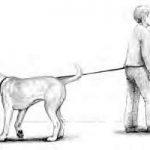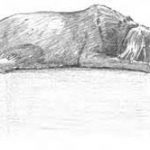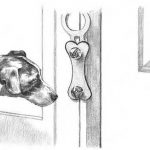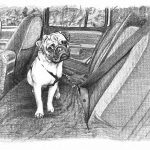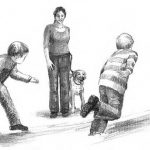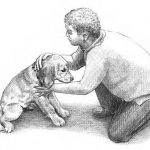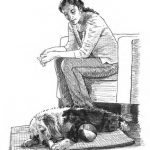Understanding Your Dog


In This Chapter
- Discovering how dogs came to be human companions
- Understanding that dogs aren’t wolves
- Recognizing that dogs are perpetual puppies
- Deciphering and dealing with hunting and chasing instincts
- Peeking into the sex life of dogs
Our goal in this chapter, and as a whole, in the entire book, is to help you understand your dog from his vantage point: to discover what it must feel like to be a dog and to understand your role and capacities to shape your dog’s behavior after you’ve developed empathy for his experience.
Your dog is not merely a four-footed person in a fur coat. Your dog is also not a wolf in disguise. Though some proponents of dog psychology emphasize the common ancestry between dog and wolf, your dog is more than a tamed version of any of its wild descendants, be it wolf, jackal, fox, coyote, or dingo. Your dog and these other canine species do share a lot of characteristics, both in physical makeup and behavior, but then humans share a lot of physical and behavioral characteristics with apes, which doesn’t mean that we are apes (although we do know a guy that we have our suspicions about).
Wolves and dogs are part of the larger group Carnivora (animals that are meat eaters and mostly live by hunting). Though each has a secondary classification specifying its distinctions, all are categorized by biologists as canines and members of the same biological family Canidae.
How Dogs Came to Be Dogs
If you were to line up all animals in the order in which they were domesticated, you would see that dogs lead the pack. In fact, dogs were brought into human’s circle well before they even knew how to grow their own food.
Technical stuffRecent evidence, based on actual fossil substantiation, suggests that dogs were domesticated between 14,000 and 17,000 years ago which is much earlier than sheep (11,000 years ago) or cats (7,000 years ago). Domestication seems to have occurred at different times in different places, with dogs first domesticated in Asia and Russia, and then separately in the Middle East, Europe, and North America.
In the beginning
Dogs and humans naturally formed an everlasting relationship. Both species were hunters that lived and survived through a dependency on a close-knit hierarchical group. The main advantage humans had over canines, in fact, was the ability to learn and reason. In comparison to others in the animal kingdom, canines are intellectually advanced.
Although the wild ancestors of dogs were efficient and daring pack hunters, they also scavenged when the opportunity arose. Scavenging about human campfires proved fruitful and was certainly less dangerous than hunting (especially if you usually hunted some of the larger hoofed animals that could kick, gore, and hurt you).
When the opportunity regularly presented a free meal, wolf packs would locate a nearby den and take advantage of these leftovers.
Technical stuffSuch leftovers were often dumped just outside the camp or village in heaps that archeologists call middens. For the wolves, middens were a veritable buffet of free food that was being continually renewed.
What sensible wolf would rather hunt when such easy pickings were available? And perfectly happy to oblige, the humans appreciated the value of having another species about that would make use of their waste, thereby keeping their camp both varmint and odor free.
Now perhaps if the relationship had just stopped there, no further domestication would have occurred. However, humans and canines share another important similarity—namely, both are territorial.
Wild canines came to view the area around the camp as their territory. As a result, when a threatening wild animal or a marauding band of strangers came close to the encampment, the canines created a commotion. The noise gave enough warning for the inhabitants of the camp to rally some form of defense, which was especially useful at night. As a result of the vigilance of these canines, the lives of the nearby humans became much safer.
First move, wolves
Domesticating dogs wasn’t simply a matter of some Stone Age man’s finding a wolf pup and bringing it home where it would be fed, sheltered, and treated like a dog. It may sound surprising, but the first stages of domestication were probably done by the wolves, themselves.
The only wolves that could benefit from discarded food were those that could comfortably coexist with humans. If a particular wolf was aggressive or threatening, he was simply killed by the human residents as a matter of safety. This process began the genetic elimination of the most destructive individuals. Animals that were friendlier and less fearful could stay closer to the settlement. In addition to free meals, such closeness provided them protection from predators that preferred to avoid human contact. When these friendlier canines began to interbreed, they ultimately generated a race of animals that were much more dog-like. In these new animals, the genes for tameness were predominant.
Technical stuffDomestication takes more than simply taming a wild animal. A tame animal allows a human to care for it and accepts human presence and control to some degree. A domesticated animal, however, is genetically modified. Humans exert control over its breeding patterns, which leads to an animal that is drastically different in both physical appearance and behavior than its wild ancestors. Certainly, no one would ever mistake a Pekingese or a bulldog for a grey wolf based on what they look like and how they act.Don’t try to tame a wolfResearch shows that instantaneous domestication is just not possible. Researchers have often tried hand feeding wolf puppies from birth and rearing them with a human family, and the results have been far from satisfactory.In virtually all the scientific studies, as the wolf cubs matured, they became more wolf-like in their behavior: The previously “tame” cubs began to stalk and hunt farm animals, other house pets, and even children, growing ever more socially dominant and challenging their people for control. Although, as a puppy, such tame wolves can learn basic obedience commands, they stop responding to them when they’re adults and begin challenging the authority and status of humans. Many reports tell of such supposedly domesticated wolves attacking and biting their handlers.
What happened next is best explained by some research done by the Russian geneticist Dmitry K. Belyaev, who was trying to re-create the domestication of dogs. He decided not to use wolves because, in many areas, evidence suggests that domestic dogs have interbred with wolves and any dog genes would contaminate the data. Instead, he used another canine species, namely silver foxes. Also, because silver fox fur is prized for making expensive garments, there was the potential for some economic benefits if he could domesticate these foxes and make them easier to raise on a farm.
The only form of genetic manipulation that Belyaev used was similar to what occurred naturally around prehistoric villages. He looked for the animals that were the most tame — the least fearful and aggressive. These animals were the only ones bred for successive generations. The most tame and friendly animals were bred with other tame and friendly animals, and after only six generations, noticeable differences existed between the tame and wild foxes. After 35 generations, this research created animals that looked and acted so much like a dog that they could be sold as pets and live in a human family. If you saw one of them walking down a street, you’d most likely believe that you were looking at some exotic breed of domestic dog.
What really happened to change a fox into a dog? Genetic changes aren’t governed by a simple process. Because of the ways that our chromosomes are constructed, it turns out that if you want to change one specific feature genetically, you often end up changing other characteristics as well. That is exactly what happened when researchers began to breed foxes in a way that encouraged the genes associated with friendliness and tameness. It happens that these traits are linked to other genes so that selective breeding for tameness actually changed Belyaev’s foxes physically and behaviorally. We now know that the resulting genetic mix actually changed the timing and rate of physical and psychological development in these new “dogs” so that they physically appear more dog-like as well.
Second move, humans
Because the wild canines hanging around the camp (see the preceding section) were more docile and friendly, some clever Stone Age person realized that if these canines would protect whole camps, why couldn’t one protect an individual hut? Protection at a personal level. Hmmm. . . .
This development turned out to be a fortunate choice because, in the end, dogs would demonstrate other behaviors that would help keep early man (and his successors) alive, including
– Serving as a hunting partner to help find and then flush, run down, and capture game– Assisting in herding flocks of animals– Acting as a warrior or comrade-in-arms– Participating in military actions or acting as an actual guard against attack– Finding items by scent, including food, lost people, and propertyJust for funEver hear the expression, “It’s a three dog night?” It came from Newfoundland where people would often tuck a dog or two under the covers to stay warm. Their expression was, “It’s so cold, you’re gonna need three dogs to keep you warm tonight!” But using dogs, whose body temperature is higher than humans, as a biological heat source isn’t limited to this region of the world — all over the globe dogs are used to keep us warm.
Perpetual puppies
In truth, what the domestication process accomplished was to arrest dog development in a very puppylike state. In essence, domestic dogs are the Peter Pans of the canine world.
Which wild canines became dogs?More than 30 different species of wild canines are candidates for the first animal that humans domesticated into a dog, but which species did humans actually take into their homes and make their closest animal companion?DNA evidence suggests that the first wild canine that was domesticated was the grey wolf, though other types of wolves and also jackals, coyotes, wild dogs, dingoes, and even some varieties of fox got into the mix. As a result, any one dog may have a combination of genes from all these various members of the canine family. Researchers know this fact because domestic dogs can interbreed with any of these species (the exception being some of the common fox species, such as the red fox, which have the wrong number of chromosomes). The offspring from such matings are live, healthy, and fertile, which is usually taken as evidence that they’re all the same species or, according to evolutionary theory, at least have a relatively recent common ancestor.This research suggests that the dog at your side may be some random mix of genes, perhaps 40 percent wolf, 30 percent jackal, and 30 percent coyote, while another breed may be 60 percent wolf, 10 percent jackal, 15 percent arctic fox, and 15 percent dingo. No wonder so many different breeds have so many different physical appearances, behavioral styles, and personalities.Technical stuffNeoteny refers to certain features normally found only in infants and young juveniles, but which in certain animals persist into adulthood.
If you look closely at Figure 2-1, you may note that many of the physical features of an adult domestic dog resemble those of a wolf puppy more than those of an adult wolf. Figure 2-1 shows common physical differences between wolves and dogs that come about because of neoteny. As you move down the arrow, you move farther away from adult characteristics and toward more puppylike features. Notice that at the very bottom of the figure, you see sort of a super puppylike dog whose features are even more immature than those found at all in wolves — at least beyond a newborn pup.

In terms of relationships with dogs, however, the behavioral aspects of neoteny are most important. Dogs keep a number of puppylike behaviors that wolves lose as they mature. These puppy behaviors are what make dogs fine companions, while the adult canine behavior makes wolves so difficult to tame. Table 2-1 offers an interesting look at what the adult wolf characteristics are like compared to the wolf-puppy characteristics that you see in dogs.


Behavioral Traits Bred in the Bone
Though no one seriously worries that their pet dog will stalk, kill, or eat their neighbor, many dogs still get busted for stealing the roast off the countertop, chasing bicycles, or tipping over garbage cans. Case in point: Although dogs have been domesticated, their genetic heritage as hunting predators hasn’t completely disappeared. It has, however, as with many other aspects of canine behavior, been modified in both strength and likelihood of occurrence. As in the case of neoteny, different breeds may show more or less of these behavior patterns (see Interpreting Your Dog’s Breed-Specific Traits).
In wolves and other wild canine predators, the hunting sequence is complete and balanced, with a fairly fixed sequence of behaviors that occur during a hunt:
- Searching
- Stalking
- Chasing
- Biting
- Grabbing
- Killing
During the process of domestication, and then later by selective breeding, humans have created specific breeds in which some or all of these six steps have been changed in their strength — either made stronger or weaker. Many of these dogs are so driven by their genetically specified hunting instinct that merely enacting the behavior is a sufficient reward in and of itself.
– The searching instinct in dogs used for narcotics detection or search-and-rescue work must be strong enough to keep these animals hunting for hours in the hope of finding their quarry. A dog with little searching instinct won’t turn out to be a successful detection or search dog.– Chasing is strongest in the sight hounds, such as the greyhounds, and you can see the power of this instinct in a dog race.– Herding dogs, such as Border Collies, use the stalking and chasing aspects of their hunting instinct to control the movement of sheep and other animals. However, they do not grab, bite, or kill their charges.– Corgis carry the behavior a bit further, all the way up to the biting stage (Step 4) because they regularly nip at animals to get them moving. Again, grabbing and killing is forbidden.– Retrievers are expected to search, chase, and grab prey to bring back to their human hunting companion. However, both the strength of the biting and their killing instincts must be toned down because the dogs must not damage the birds they retrieve.– In scent hounds, such as Beagles or Bloodhounds, the searching component of their hunting instinct has been increased to ensure a dedication to the detection, tracking, and finding of quarry.– Working terriers used to control rats or go after foxes have only a weak searching instinct, but their chasing, biting, and grabbing instincts are all present in full force.– For some terriers, such as the Staffordshire Bull Terriers or the American Pit Bull Terriers, the grabbing instinct has been greatly amplified. These dogs were originally bred to be used in bull baiting, a blood sport where they were placed in a pit and required to restrain bulls by biting and hanging onto their noses to bring them to their knees. Obviously, searching or stalking was not needed in these animals, so those behaviors were weakened.Just for funVery often, strong hunting instincts go hand in hand with high levels of energy and intensity in a dog. Lots of play with balls, Frisbees, Kongs, or other toys is a good way to use up that energy while at the same time activating your dog’s natural instincts to chase, capture, or retrieve a moving object.
Curing the Dog with an Overdeveloped Chasing Instinct
In some dogs, the chase instinct is so strong that it becomes a problem. Such dogs chase everything: cars, bikes, skaters, joggers. Anything that moves seems like it may be prey and triggers the chasing component of the hunting instinct. Such behaviors aren’t only annoying, but may be dangerous, such as when a dog chases a car down the street and gets hit by a car or chases a person on a bicycle, causing them to swerve and fall.
If your dog has a strong hunting instinct, you can take some common-sense precautions to help keep him out of trouble:
– Always leash your dog when he is walking through fields or yards containing livestock or near playgrounds with active kids. Also, keep your dog on his leash in places where swiftly moving vehicles, bikes, or skateboarders can instigate the chase instinct.– Don’t allow your dog to stray too far from you when out on walks.– Never leave your dog alone with small pets, such as rabbits and hamsters, infants, toddlers, or small children.TipThe most general solution to problem chasing behavior involves taking the dog’s attention away from the situation producing the behavior and giving him a competing behavior that interferes with the chase. Initially, the dog must learn a command, such as “Stop it!”, to halt the chase and turn his attention to you.How strong is your dog’s hunting instinct?Are you living with a real predator? Here is a simple test that can help you judge the degree of your dog’s hunting instinct.Start by attracting your dog’s attention to a favorite toy. Then toss the toy across the room and watch his reaction.He ignores the toy. Don’t bother looking for the wolf in this dog. His hunting instinct is virtually absent.He runs after the toy, but does not pick it up. The chase instinct is present but little else, which indicates a low overall hunting instinct.He picks up the toy and carries it all the way, or part of the way, back to you. Chase and grab are present, evidencing a moderate level of hunting instinct.He pounces on the toy, shaking and chewing it. This reaction is a strong hunting instinct, with all the main behaviors present. Your dog is still a hunter!Having a dog with a strong hunting instinct (sometimes called prey drive) is not necessarily a bad thing. Hunting instincts invade every part of a good working dog’s training, whether tracking, obedience, or protection. Many dog sports, such as flyball or Frisbee, depend upon hunting behaviors and instincts.
TipThe choice of the command to stop chasing is important. When a child or a cyclist is being chased by a dog, they naturally respond by shouting “Stop” or “Stop it!” When the dog hears those words from the person that he’s distressing, he should understand that he’s being told to break off the chase (without any need to teach anything to the person being chased).
- Start with the chase recall.
For this training exercise, you need two people and at least two of your dog’s favorite retrieving or chasing toys. It may help to start indoors where there are fewer distractions or in a quiet enclosed area outdoors.
- Start by having one person hold the dog and then throw the toy past the other person, who is standing about 15 feet away.
- Randomly, say every third or fourth throw, the other person should catch the toy, hide it out of sight, and, as the dog starts to run toward him, the person hiding the toy shouts “Stop it!”
Normally, once your dog realizes the toy has disappeared, he looks back at you.
- As soon as that happens, show the dog the other toy, throw it in the opposite direction, and run in the direction that you tossed it to make it more likely that the dog will enthusiastically chase it.
What the dog is learning is that by responding to “Stop it,” by breaking off the chase and looking at you, good things are apt to happen.
- Next put the dog on a long leash and take your dog to a place that contains things that he usually chases. When he starts to chase something, yell “Stop it!” and bring him back to you for some praise and an occasional treat.
The dog gradually learns to break off chasing on command.
TipWhen you can roll a ball away from your dog and he doesn’t chase it when you command him not to, then you know that he’s under control.
Understanding Your Dog’s Sex Life
Dogs are a lot more sexually promiscuous than their wild cousins. Compared to wolves, for example, dogs tend to reach puberty (sexual maturity) between 7 and 10 months of age, while wolves are sexually immature until they’re 22 to 24 months of age.
Technical stuffSmaller dogs tend to reach puberty earlier than larger dogs.
Dogs are also a lot more promiscuous than wolves. Generally speaking, wolves are relatively monogamous, with the leadership (or alpha pair) forming a sexual partnership with another wolf and sticking to that relationship fairly exclusively.
Dogs, on the other hand, are philandering Casanovas. They’re polygamous and are willing to accept multiple sexual partners: an attribute deliberately selected during the domestication process, allowing them to breed more freely. (Needless to say, this trait was a good thing in the eyes of humans because it allowed chosen dogs to be readily mated with partners selected not by them but by their breeders.)
Another adjustment that came about through the process of domestication was a change in dogs’ breeding cycles. Female wolves come into season and are sexually receptive and fertile only once per year. Female dogs, on the other hand, come into season and can be bred twice a year, with few exceptions — namely dogs that are very close to their “wild ancestors,” such as the Basenji, which comes into heat only once a year.
Just for funMost people don’t know that a male reproductive cycle, at least in wild canines, occurs. Male wolves are able to breed only during a short period each year. Between breeding seasons, the male wolf’s testes actually shrink and become unable to produce sperm. Male dogs, however, seem to be randy all the time. They’re fertile and willing to mate whenever a receptive female is available.
For the eight or nine days before ovulation and for the next nine days when the female dog is fertile, major hormonal changes occur. Females in heat become more playful around males in general, although they also become more aggressive toward males that they want to reject.
RememberIn dog matings, the choice is always up to the female! The most dominant male doesn’t always get to mate with the female. If she wants to reject a dominant male, she simply rolls over on her back or side and refuses to stand for his attentions. Less dominant dogs who are rejected, however, get nipped and growled at. The female may also become more aggressive around other females at this time.Domestic overpopulation crisisIn evolutionary terms, dogs are more than a thousand times more successful than wolves based on their numbers. It is estimated that more than 400 million dogs exist in the world (which is equivalent to the human populations of the United States, Canada, Great Britain, and France combined) compared to a worldwide total of only 400,000 wolves.One reason for dogs’ biological success has to do with their shortened breeding cycles. An average female dog can have her first litter of puppies when she is only 10 to 12 months of age. It takes 58 to 70 days to have the puppies. The average number of pups is usually between 6 and 10. Every female dog can have two batches of puppies each year. Now, if half of these puppies are female, they can also have pups when they grow up. That means that one female dog and her offspring can produce 4,372 puppies in just seven years!
The truth about spaying and neutering
When dogs are brought to veterinarians to be neutered, the scene usually involves a wife agreeing to the procedure while her husband sits with his legs crossed and appears uncomfortable. Though neutering is obviously done to prevent the birth of unwanted puppies, it also affects the behavior of dogs — and almost always for the better.
In male dogs, the dramatic reduction in hormones after neutering reduces their desire to mark their territory with urine, to be aggressive with other male dogs, and to wander from home following sexual scents.
In female dogs, the effects are mostly on the twice yearly changes that occur when she’s in heat, such as protective urges for puppies, or puppy substitutes, such as toys. In female dogs, however, the reduction in the hormone progesterone, which normally has calming effects, can exaggerate dominance behaviors in an already dominant female.
RememberThe major benefits to society from spaying female dogs is that it reduces the overpopulation of unwanted dogs, who eventually end up living in the streets or euthanized by dog pounds. It also reduces the likelihood that every hopeful male dog in the neighborhood will show up at your doorstep or molest you on your walks when your furry girl goes into heat.RememberNeutering doesn’t affect house guarding, fear biting, and predatory or territorial aggression.
Now or later? The best age to spay or neuter a dog
Science is quite clear that just before puberty is an excellent time to carry out this procedure. Neutering a dog before it reaches sexual maturity freezes its personality in its present puppylike form. If you like your dog’s personality at 6 months of age and your veterinarian agrees, there is no reason not to neuter him or her at that age.
Neutering a dog too early (say, at 2 or 3 months) may affect the dog’s growth patterns as well as his personality. It appears that certain levels of sex hormones are needed for the dog to grow to its full size and to allow it to develop some aspects of adult behavior. You see, Mom was wrong — it’s not too much sex that stunts your growth, but too few sex hormones.
WarningThe scent of a female dog in heat can drift over a quarter of a mile and attract male dogs to her vicinity. The nearness of a sexually receptive female can make male dogs quite excited and aggressive toward other male dogs. It can also cause frustration within the confines of a house, causing otherwise sedentary dogs to wander well away from home.
by Stanley Coren and Sarah Hodgson









